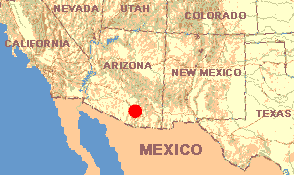 March 4,
1988
March 4,
1988ARIZONA: Pima County
University of Arizona campus in Tucson
 March 4,
1988
March 4,
1988Sunday at dawn, even before the Mexican Jays arrive, Henry starting hard in the cold, away we go again. Out of the mountains, and then thirty miles of straight gravel road across a rolling plain of grass and scrub, past ranches with broken-down windmills and yards filled with rusting pickup trucks, then through Douglas, Bisbee, Tombstone and Benson, and finally northwest, back on I-10 again. Just across the border of Arizona's Pima County, in a rocky canyon to my right, unmistakably, a twenty-foot-tall Saguaro Cactus appears, welcoming us to the Sonoran Desert.
On I-10 inside Tucson a sign announces the University of Arizona, so I take the next exit. Parking near the Newman Center I disembark for parts unknown. The kids, wearing shorts, smell of morning showers and hamburgers with dill pickles and onions. I still smell of woodsmoke. Like massive, kilt-wearing sentinels wearing green ceremonial plumes, thirty-foot high Washington Palms stand at attention along the avenue south of the Student Union. At the Union's southeastern corner the Joseph Wood Krutch Garden bristles with fantastic, impossible cacti and agaves. Its Ocotillo, unlike the ones we've seen so far, are green with leaves. And here's the unlikely Boojum from Baja California, looking like a gray-green, swollen-based, thin-haired rat tail stuck fifteen feet straight into the sky.
At the plaza's edge not far from the Boojum I sit being washed with boom-box rock-and-roll and the odor of suntan lotion, trying to relate the present with four hours earlier in the cold dawn forest in New Mexico. My hiking boots, old jeans and thorn-scratched, sunburned arms are too out-of- place here. And the Krutch Garden disorients me. Too many specialties in one place. Too much show, no room for soul. These generous cacti like perfect tigers in tiny cages. But House Sparrows mating in the sand between the giant Saguaros' trunks please me greatly.
Now walking northward I pass a fountain-side garden with seven distinct colors of Snapdragon all planted in perfect ranks and files. Though Snapdragon's look like delicate herbs, actually they are woody perennials. It's just that when you see them planted in gardens like this they're just herbaceous sprouts being planted for one season. In the fall they'll be dug up and destroyed. Then next year another crop of trash-bin destined sprouts will be planted again, and neither will they be given the chance to grow woody. Sitting beside the fountain on this sunny, spring afternoon at the University of Arizona I feel profoundly sorry for Snapdragons.
On down the street the eucalyptus tree called Ribbon-gum is flowering. When crushed, its slender, scythe-shaped leaves smell of menthol. Not far away lies a bed of bright, dog- faced pansies, and across the street the roses are beginning to bloom. For a moment I stand beside a Forsythia bright with yellow blossoms.
Continuing the walk, it becomes apparent that this campus is absolutely swarming with different species of eucalyptus, not just Ribbon-gum. Here are round-leafed species and species with stringy leaves, and some species I wouldn't even guess could be eucalyptuses were I unable to see the flowers and fruits. And twenty species of palm, must be here, too. Suddenly I lose my interest in meeting more ornamentals and just sit in the grass, glad that in almost one out of three palms House Finches perch singing their hearts out.
From this campus one always can look down the long streets (streets with palms) to see the mountains -- the Tortolita, Roskruge, Sierrita and others -- with their gray, dry, deserty slopes. In the moist, green grass, surrounded by laughter, bright frisbees and rock-and-roll, after only a couple of hours of being with people I'm needing to return to the desert's grayness.